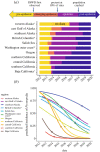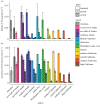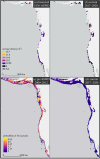Disease-driven mass mortality event leads to widespread extirpation and variable recovery potential of a marine predator across the eastern Pacific
- PMID: 34428964
- PMCID: PMC8385337
- DOI: 10.1098/rspb.2021.1195
Disease-driven mass mortality event leads to widespread extirpation and variable recovery potential of a marine predator across the eastern Pacific
Abstract
The prevalence of disease-driven mass mortality events is increasing, but our understanding of spatial variation in their magnitude, timing and triggers are often poorly resolved. Here, we use a novel range-wide dataset comprised 48 810 surveys to quantify how sea star wasting disease affected Pycnopodia helianthoides, the sunflower sea star, across its range from Baja California, Mexico to the Aleutian Islands, USA. We found that the outbreak occurred more rapidly, killed a greater percentage of the population and left fewer survivors in the southern half of the species's range. Pycnopodia now appears to be functionally extinct (greater than 99.2% declines) from Baja California, Mexico to Cape Flattery, Washington, USA and exhibited severe declines (greater than 87.8%) from the Salish Sea to the Gulf of Alaska. The importance of temperature in predicting Pycnopodia distribution rose more than fourfold after the outbreak, suggesting latitudinal variation in outbreak severity may stem from an interaction between disease severity and warmer waters. We found no evidence of population recovery in the years since the outbreak. Natural recovery in the southern half of the range is unlikely over the short term. Thus, assisted recovery will probably be required to restore the functional role of this predator on ecologically relevant time scales.
Keywords: Pycnopodia helianthoides; echinoderm; mass mortality event; sea star wasting disease; species distribution models; temperature.
Figures





References
-
- Feehan CJ, Scheibling RE. 2014Effects of sea urchin disease on coastal marine ecosystems. Mar. Biol. 161, 1467-1485. (10.1007/s00227-014-2452-4) - DOI
-
- Lester SE, Tobin ED, Behrens MD. 2007Disease dynamics and the potential role of thermal stress in the sea urchin, Strongylocentrotus purpuratus. Can. J. Fish. Aquat. Sci. 64, 314-323. (10.1139/f07-010) - DOI
Publication types
MeSH terms
Associated data
LinkOut - more resources
Full Text Sources
Miscellaneous

